QUICK SUMMARY
-
-
Positive Vibes Only: Ditch the scolding and reward those good behaviors like there's no tomorrow!
-
Consistency is King: Keep those training sessions regular and predictable. Your Rottie pup loves routine!
-
Socialize, Socialize, Socialize: Introduce your Rottie pup to the world and watch their confidence soar.
Think Rottweiler puppies are all bite and no brains? Think again!
Okay, we get it. Rottweiler pups have a reputation—those sharp teeth and playful nips can be a bit intimidating. But guess what? Underneath that tough exterior is a loving, loyal companion just waiting for the right guidance. And that’s where puppy training comes in!
Why Rottweiler Puppy Training Matters
Rottweilers are intelligent, strong-willed, and protective. Without proper training, those adorable puppy behaviors can turn into not-so-adorable adult habits. Nobody wants a 100-pound lapdog who thinks the mailman is a threat! (Or your grandma…)
With the right approach, you can raise a Rottweiler who’s a joy to be around. We’ll walk you through everything you need to know, from potty training and basic commands to socialization and addressing those strong Rottie instincts.
Your Rottweiler Puppy Training Roadmap
Okay, we get it. Rottweiler pups have a reputation—those sharp teeth and playful nips can be a bit intimidating. But guess what? Underneath that tough exterior is a loving, loyal companion just waiting for the right guidance. And that’s where puppy training comes in!
Here’s the thing: Rottweiler puppy training isn’t just about teaching commands. It’s about building a foundation for a happy, well-adjusted dog. Here’s how:
Housetraining Your Rottweiler Puppy: No More Accidents!
Okay, let’s be real, nobody wants a Rottweiler-sized accident in their living room, right? But don’t worry, with a bit of consistency and a whole lot of patience, you can have your Rottie pup housebroken in no time.
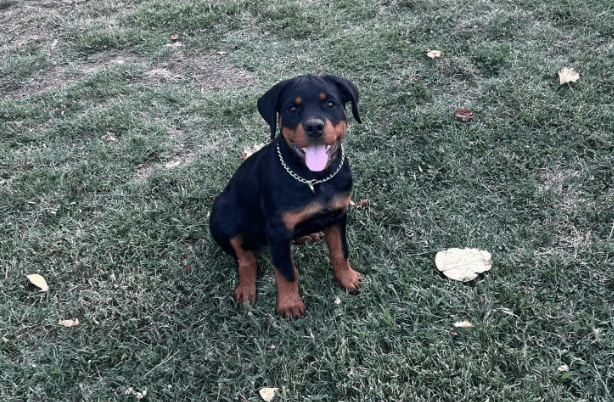
- Routine is Key: Just like us, Rotties need a regular bathroom schedule. Take your pup out first thing in the morning, after naps, after meals, and before bedtime.
- Positive Vibes Only: Accidents happen! Instead of scolding, focus on rewarding your pup when they potty outside. Think praise, treats, and maybe even a little happy dance!
- Crate Training Can Be a Big Help: A crate can be a super helpful tool for housetraining. Dogs instinctively avoid soiling their sleeping area, so a crate can encourage them to hold it until you take them outside. But remember, even with crate training, accidents can happen. If your puppy keeps pooping in the crate, it might be a sign that they need more frequent potty breaks or that the crate is too large for them.
- They’re Still Babies!: Remember, your Rottie pup is still learning! At 8 weeks old, they can realistically hold it for about 5-6 hours overnight. So, if you’re crate training, make sure those nighttime crating sessions aren’t too long. If your puppy cries in the crate at night, they might need a potty break, or they might just be feeling a little lonely. Try to soothe them without taking them out of the crate unless you’re sure they need to eliminate.
With a little effort and a lot of positive reinforcement, you’ll have your Rottie pup housetrained in no time. And trust me, a clean house is worth celebrating!
Crate Training Your Rottweiler: A Cozy Den for Your Big Softie
Okay, let’s talk about crate training! Now, before you picture your Rottie pup locked away in a cage, let’s reframe that image. A crate isn’t a prison; it’s a cozy den, a safe haven for your furry friend.
Think of it like their own little apartment within your home. It’s a place where they can relax, unwind, and catch some Z’s without the worry of getting into mischief. Plus, crate training can be a lifesaver when it comes to housetraining (nobody wants a Rottweiler-sized accident on their new rug!). The Humane Society emphasizes the benefits of crate training, highlighting its role in housetraining and providing a safe space for your Rottweiler puppy
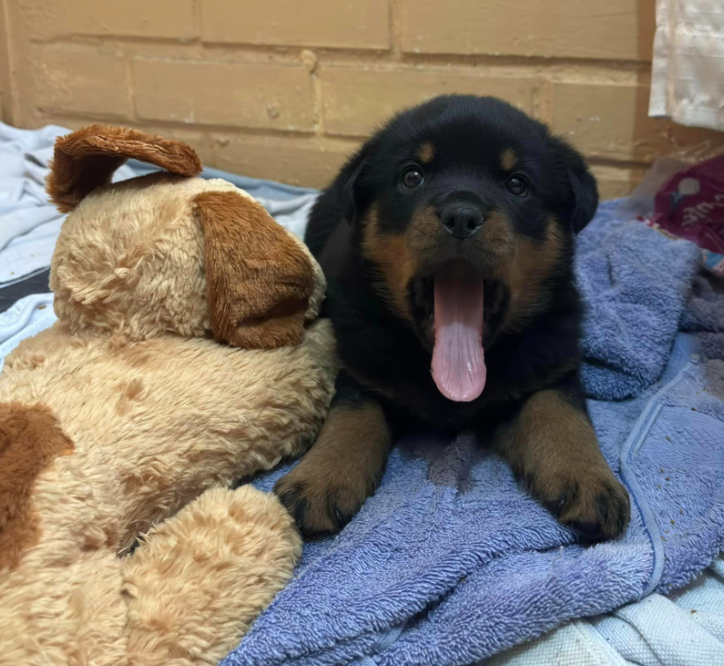
- Cozy Crib: Make the crate comfy! Add a soft bed or blanket, maybe a favorite toy or two. You want your Rottie pup to associate the crate with good vibes only.
- Easy Does It: Introduce the crate gradually. Start by tossing treats inside and letting your pup explore at their own pace.
- Mealtime Magic: Feed your pup their meals in the crate. This helps them build a positive association with their new den.
- Safe Haven: Encourage your pup to use the crate for naps and bedtime. A consistent routine will help them settle in faster.
Remember, crate training is all about creating a positive experience for your Rottie pup. With patience and consistency, they’ll soon see their crate as their own personal retreat. If your puppy is crying in the crate, try to soothe them without taking them out unless it’s potty time. You don’t want them to learn that crying equals freedom!
Basic Obedience: Laying the Foundation for a Rockstar Rottie
Alright, let’s get down to business! Basic obedience is like the ABCs of dog training. It’s the foundation for a well-behaved Rottweiler who listens, even when they’d rather chase squirrels or sniff every blade of grass in the park. Victoria Stilwell, a renowned dog trainer, offers valuable insights into teaching basic commands using positive reinforcement methods.
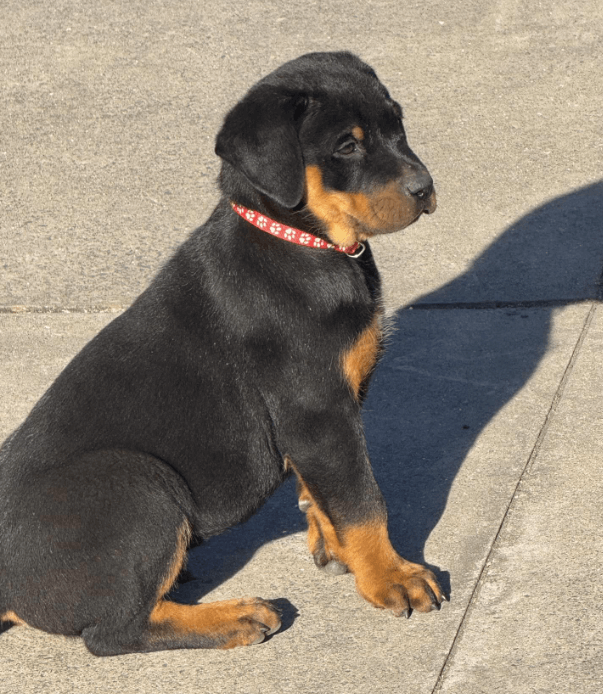
- Start with the Essentials: “Sit”, “Stay”, “Come” – these commands are like gold for any Rottie owner. They help you manage your pup in everyday situations, from greeting guests to keeping them safe on walks.
- Keep it Fun and Engaging: Rottweilers are smart cookies, but they can also get bored easily. Keep training sessions short and sweet (around 5 minutes at first) and use plenty of positive reinforcement. Think treats, praise, and maybe even a little victory dance when they nail a command!
- Consistency is King: Just like with housetraining, consistency is key for obedience training. Practice those commands regularly, in different environments, and watch your Rottie pup transform into a well-mannered superstar.
- Be Patient, They’re Learning: Remember, your Rottie pup is still a little sponge, soaking up all the new experiences and information. Be patient and understanding, and they’ll get there!
With a bit of effort and a lot of positive reinforcement, you’ll have your Rottie pup mastering those basic commands in no time. And trust me, a well-behaved Rottie is a joy to be around!
Socialization: Introducing Your Rottie to the World
Alright, let’s talk socialization! It’s like throwing a welcome party for your Rottie pup, introducing them to all the amazing things the world has to offer – people, places, and other furry friends. Think puppy classes, dog parks, trips to the pet store, and friendly faces everywhere they go.
- Fear Buster: Early socialization helps prevent fear-based aggression. By exposing your Rottie pup to different sights, sounds, and experiences, you’re helping them build confidence and learn that the world isn’t a scary place
- Well-Mannered Pup: Socialization helps your Rottie pup learn how to behave around others. They’ll discover the joy of playing with other dogs, greeting people politely, and navigating different environments without a fuss.
- Happy and Healthy: A well-socialized Rottie is a happy and healthy Rottie. They’re less likely to develop behavioral issues, and they’ll be more comfortable in a variety of situations.
Important Note: Before you unleash your Rottie pup on the world, make sure they’re fully vaccinated. Puppy playdates and dog park adventures are awesome, but you want to keep your little one safe from any potential doggy diseases. If you’re introducing your puppy to an older dog, do it gradually and in a controlled environment.
Biting Prevention: Those Sharp Puppy Teeth!
Okay, let’s talk about those needle-sharp puppy teeth! Rottweiler pups are known for their playful nips and enthusiastic chomps, but it’s important to teach them early on that biting isn’t okay. The ASPCA provides practical advice on managing puppy biting, including redirection techniques and appropriate correction methods.
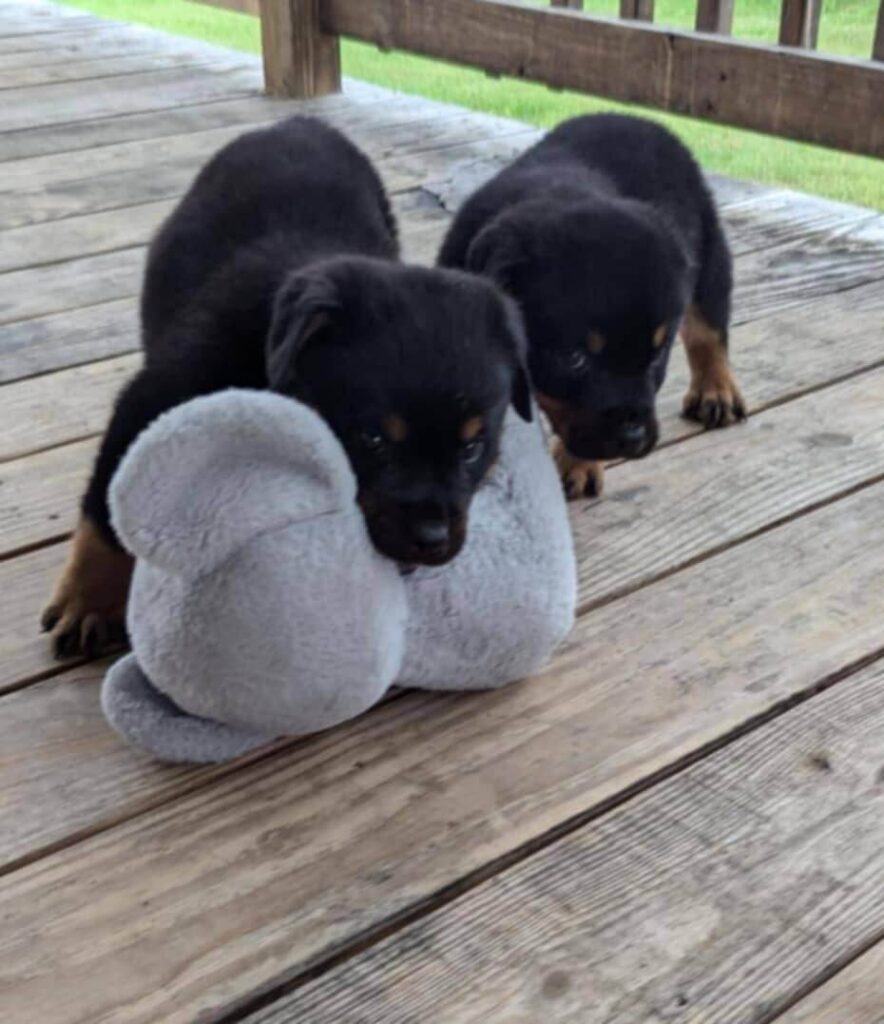
- Redirect, Redirect, Redirect: When your Rottie pup starts nipping, redirect their attention to an appropriate chew toy. This helps them learn what they can chew on, instead of just what they can’t.
- Ouch! That Hurts: If your pup nips you too hard, let out a yelp or say “ouch!” in a firm voice. This mimics how dogs communicate with each other, and it can help your pup understand that they’ve crossed a line.
- Time Out: If the nipping continues, give your pup a brief time-out. This could mean gently placing them in their crate or moving them to a designated “calm down” spot.
- Consistency is Key: Just like with all training, consistency is crucial. Every time your Rottie pup nips, redirect, correct, and offer an alternative. They’ll get the message eventually!
- Don’t Sweat the Small Stuff: Remember, Rottweilers were bred to herd and protect, so some nipping and chasing behaviors are natural. Don’t make a big deal out of these instincts, but do correct them consistently. If you have a humping puppy, don’t worry, it’s usually just a playful behavior. But if it becomes excessive, you can redirect them to a more appropriate activity.
With patience and positive reinforcement, you can teach your Rottie pup to keep those sharp teeth to themselves. And trust me
Chewing Management: Protecting Your Furniture (and Your Pup!)
Okay, let’s be real, those puppy teeth can do some serious damage! But don’t worry, with a bit of planning and the right approach, you can protect your furniture and keep your Rottie pup happy.
- Chew Toy Central: Stock up on a variety of chew toys. Think different textures, shapes, and sizes to keep your Rottie pup entertained and satisfied.
- Safety First: Make sure those chew toys are durable and safe. Avoid anything that can be easily torn apart or swallowed, as this could lead to choking or intestinal blockage.
- Redirect and Reward: When you catch your Rottie pup chewing on something they shouldn’t, redirect them to an appropriate chew toy and offer praise or a treat. They’ll soon learn what’s okay to chew on and what’s off-limits.
- Safe Space: Puppy-proof your home! Keep valuable items out of reach and provide a safe, designated area where your Rottie pup can play and explore without getting into trouble.
- Keep Them Busy: A tired pup is less likely to get into mischief. Make sure your Rottie pup gets plenty of exercise and mental stimulation to prevent boredom-induced chewing.
With a little effort and a lot of positive reinforcement, you can teach your Rottie pup to be a respectful chewer. And trust me, your furniture will thank you!
Barking Control: A Quieter Rottie is a Happier Rottie (and Neighbor!)
Okay, let’s talk about barking! Rottweilers aren’t known for being excessive barkers, but they definitely have a voice when they need it. The key is to teach your Rottie pup when barking is appropriate and when it’s time to zip it.
- Listen Up: Pay attention to when and why your Rottie pup barks. Are they barking at the doorbell, passersby, or just for attention? Identifying the triggers is the first step to managing the barking.
- Positive Reinforcement is Your Friend: When your Rottie pup is quiet, reward them with praise, treats, or a favorite toy. They’ll soon learn that silence is golden (and delicious!).
- Ignore Attention-Seeking Barks: If your Rottie pup is barking just to get your attention, ignore them. Don’t give in, even if it’s tempting! Once they realize that barking doesn’t get them what they want, they’ll be more likely to stop.
- Keep Them Busy: A tired Rottie is a quieter Rottie. Make sure your pup gets plenty of exercise and mental stimulation to prevent boredom-induced barking.
- Don’t Encourage the Barking: Avoid inadvertently rewarding barking. For example, if your Rottie pup barks at the doorbell and you immediately go to the door, you’re actually reinforcing the barking behavior.
With patience and consistency, you can teach your Rottie pup to bark less and chill more. And trust me, your neighbors will thank you!
Leash Training Your Rottweiler: Strolls, Not Tugs!
Alright, let’s talk about leash training! Nobody wants to be dragged down the street by their Rottie pup, right? The good news is, with a bit of patience and the right approach, you can teach your little tank to walk politely on a leash.
Here’s the thing:
- Start Early, Start Short: Introduce leash walking as early as 8 weeks old. Begin with short walks around the house or yard, gradually increasing the duration as your Rottie pup gets the hang of it.
- No Pulling Allowed: If your pup starts to pull, stop in your tracks. Don’t yank or pull back on the leash, as this can actually encourage them to pull harder. Wait for them to loosen the leash, then continue the walk.
- Rewards for Good Behavior: When your Rottie pup walks nicely by your side, offer praise, treats, or a favorite toy. They’ll soon learn that walking politely leads to good things!
- Make it Fun: Keep those walks interesting! Explore different routes, let your pup sniff and explore, and make it a positive experience for both of you.
- Consistency is Key: Just like with all training, consistency is crucial. Practice leash walking regularly, and your Rottie pup will soon be strolling like a pro.
With a little effort and a lot of positive reinforcement, you’ll have your Rottie pup walking politely on a leash in no time. And trust me, those leisurely strolls together will be a joy for both of you!
Recall Training: “Come!” (and Actually Mean It!)
Okay, let’s talk recall! Imagine this: you’re at the park, your Rottie pup is frolicking in the sunshine, and you call out “Come!”. And guess what? They actually come back! No chasing, no pleading, just pure, joyful obedience. That’s the magic of recall training.
- Start in a Safe Space: Begin practicing recall in a controlled environment, like your living room or backyard. Use a long leash at first to prevent any escapes.
- Make it Irresistible: When you call your Rottie pup, make it worth their while! Use an enthusiastic voice, offer high-value treats, and shower them with praise when they come running.
- Gradually Increase Distractions: Once your pup has mastered recall in a quiet setting, start adding distractions. Practice in the park, around other dogs, or with tempting smells in the air.
- Be Consistent: Just like with all training, consistency is key. Practice recall regularly, in different environments, and watch your Rottie pup become a recall rockstar.
- Off-Leash Freedom: Once your pup has mastered recall with distractions, you can start enjoying off-leash adventures. But remember, safety first! Choose secure areas and always be mindful of your surroundings.
With patience and positive reinforcement, you can teach your Rottie pup to come when called, even with squirrels and butterflies tempting them away. And trust me, that kind of freedom and trust is priceless!
Impulse Control: Teaching Your Rottie to “Wait” and “Leave It”
Okay, let’s talk impulse control! Rottweilers are known for their enthusiasm and sometimes, well, let’s just say they can be a bit impulsive. But don’t worry, with a bit of training, you can teach your Rottie pup to channel their inner zen master and resist those tempting impulses.
Here’s the thing:
- “Wait” for It: Teach your Rottie pup to “wait” before dashing out the door, jumping on guests, or gobbling down their food. This simple command can prevent a lot of chaos and potential accidents.
- “Leave It” is Your Magic Phrase: Whether it’s a dropped sandwich, a tempting shoe, or another dog’s toy, “leave it” is your magic phrase to prevent your Rottie pup from getting into trouble.
- Practice Makes Perfect: Start with easy exercises and gradually increase the difficulty. You can use treats, toys, or even just your hand to practice “wait” and “leave it” in different situations.
- Consistency is Key: Just like with all training, consistency is crucial. Every time your Rottie pup shows good impulse control, reward them with praise, treats, or a favorite toy.
- Patience, Young Padawan: Remember, impulse control takes time and practice. Be patient and understanding with your Rottie pup, and they’ll eventually learn to resist those tempting impulses.
With a little effort and a lot of positive reinforcement, you can teach your Rottie pup to master impulse control. And trust me, a Rottie who can “wait” and “leave it” is a true joy to be around!
Rottweiler-Specific Training Tips
Remember, Rottweilers are unique! Keep these breed-specific traits in mind:
Stubborn Streak: The Gentle Art of Rottweiler Patience
Okay, let’s talk about that stubborn streak! Rottweilers are known for their intelligence and independent thinking, which can sometimes translate to, well, let’s just say they have their own ideas about things. But don’t worry, with a bit of patience and persistence, you can teach your Rottie pup to embrace the joys of cooperation.
- Embrace the Challenge: Rottweilers are eager to learn, but they can also be strong-willed. Don’t get discouraged if they don’t pick things up immediately. Instead, see it as an opportunity to bond and build a stronger connection with your furry friend.
- Consistency is Key: Just like with all training, consistency is crucial. Set clear expectations and stick to them. Your Rottie pup will eventually learn that following your guidance leads to positive outcomes.
- Positive Vibes Only: Rottweilers respond best to positive reinforcement. Focus on rewarding good behavior with praise, treats, or a favorite toy. Avoid harsh punishments, as this can damage their trust and make them less willing to cooperate.
- Keep it Fun and Engaging: Rottweilers can get bored easily, so make training sessions fun and stimulating. Use a variety of exercises, incorporate games, and keep things interesting to hold their attention.
- Celebrate the Small Wins: Don’t get hung up on perfection. Celebrate those small victories along the way, and remember that progress is progress, no matter how small.
With patience, persistence, and a positive attitude, you can overcome that stubborn streak and build a strong foundation for a lifetime of learning and cooperation with your Rottie pup.
Dominance: You’re the Boss, Rottie!
Okay, let’s talk about dominance! Rottweilers are naturally confident and assertive, which is awesome when you want a loyal protector, but it also means you need to establish clear leadership from day one. Think of it like this: your Rottie pup is looking to you for guidance, to show them the ropes and be the boss.
- Clear Boundaries: Set clear rules and stick to them. This could mean no begging at the table, no jumping on the couch, or waiting for permission before going outside. Consistency is key!
- Positive Reinforcement is Your Superpower: Reward good behavior with praise, treats, or a favorite toy. This helps your Rottie pup understand what you expect of them and encourages them to cooperate.
- Be Confident and Assertive: Show your Rottie pup that you’re in charge by being firm and assertive, but avoid harsh punishments. A calm and confident demeanor will help them trust your leadership.
- Patience, Young Padawan: Remember, your Rottie pup is still learning. Be patient and understanding, and they’ll eventually get the hang of following your guidance.
- Don’t Back Down: Rottweilers can be stubborn (we’ll talk more about that later!), so it’s important to stand your ground. If you give in to their demands, they’ll quickly learn that they can get their way by being pushy.
Guarding Instincts: Your Rottie the Protector
Okay, let’s talk about those guarding instincts! Rottweilers were bred to protect, so it’s no surprise that they can be a bit wary of strangers or new situations. But don’t worry, with the right approach, you can help your Rottie pup channel their inner guard dog in a positive way.
Here’s the thing:
- Socialization is Key: Early and frequent socialization is crucial for preventing over-protectiveness. Expose your Rottie pup to a variety of people, places, and situations from a young age. This helps them learn to distinguish real threats from harmless encounters.
- Positive Experiences: Make those social interactions positive! Encourage friendly greetings, offer praise and treats, and help your Rottie pup associate new experiences with good things.
- Controlled Introductions: When introducing your Rottie pup to new people or dogs, do it in a controlled environment. Keep them on a leash at first, and supervise the interactions to ensure everyone feels safe and comfortable.
- Be a Confident Leader: Show your Rottie pup that you’re in charge and that they can trust your judgment. A confident and assertive demeanor will help them feel secure and less likely to overreact in new situations.
- Don’t Encourage Guarding Behavior: Avoid inadvertently rewarding guarding behavior. For example, if your Rottie pup barks at a stranger and you immediately pull them away, you’re actually reinforcing the idea that the stranger is a threat.
Prey Drive: Release the Inner Hunter (Responsibly!)
Okay, let’s talk about that prey drive! Rottweilers have a natural instinct to chase, herd, and, well, let’s just say they have a knack for keeping things in line. But don’t worry, with a bit of know-how, you can channel that prey drive into fun and productive activities.
- Keep Them Busy: A bored Rottie is more likely to chase squirrels, joggers, or anything that moves. Make sure your pup gets plenty of physical exercise and mental stimulation to prevent boredom-induced chasing behaviors.
- Engage Their Brains: Rottweilers are intelligent and eager to learn. Challenge them with activities that engage their brains, such as agility training, herding, or scent work. This helps them burn energy and satisfy their natural instincts in a positive way.
- Redirect and Reward: If your Rottie pup starts to chase something they shouldn’t, redirect their attention to an appropriate activity or toy. Offer praise and rewards when they engage in positive behaviors.
- Teach Self-Control: Impulse control exercises, like “wait” and “leave it”, can help your Rottie pup learn to resist those tempting chase impulses.
Safe and Secure: When you’re out and about, keep your Rottie pup on a leash or in a secure area to prevent any accidental chases. This is especially important in areas with traffic or other potential hazards.
Troubleshooting and Confidence Building: When Training Gets Ruff
Okay, let’s be real, even with the best intentions and a whole lot of positive vibes, training hiccups happen! But don’t worry, every training snag is an opportunity to learn and grow with your Rottie pup.
- Play Detective: If you hit a roadblock, try to figure out what’s triggering the unwanted behavior. Is your Rottie pup bored, stressed, or confused? Once you identify the root cause, you can adjust your approach accordingly.
- Be Flexible: Don’t be afraid to change things up! If one training method isn’t working, try a different one. Every Rottie pup is unique, so what works for one might not work for another.
- Don’t Be Afraid to Ask for Help: If you’re struggling, don’t hesitate to seek professional help from a certified dog trainer or behaviorist. They can offer personalized guidance and support to get your training back on track.
- Confidence is Key: A confident Rottie is a happy Rottie. Build your pup’s confidence with positive reinforcement, socialization, and fun challenges. Help them believe in themselves, and they’ll be more likely to succeed.
- Celebrate the Small Wins: Training isn’t always a linear progression. There will be ups and downs, so celebrate those small victories along the way. Every step forward, no matter how small, is worth celebrating.
With patience, persistence, and a positive attitude, you can overcome any training challenge and help your Rottie pup shine.
Q: When should I start training my Rottweiler puppy?
A: The sooner, the better! Ideally, start training your Rottie pup between 6 weeks and 6 months old. They're like little sponges at that age, soaking up all the good habits (and maybe a few bad ones if you're not careful!).
Q: What's the best way to train a Rottweiler puppy?
A: Positive reinforcement is your superpower! Reward those good behaviors with praise, treats, and maybe even a little happy dance. Rottweilers are smart and eager to please, so they'll respond best to positive vibes.
Q: Help! My Rottweiler puppy is nipping and biting!
A: Ouch! Those puppy teeth can be sharp. Redirect that nipping behavior to appropriate chew toys and teach your Rottie pup to be gentle. Remember, consistency is key!
Q: How do I stop my Rottweiler puppy from pulling on the leash?
A: No more tug-of-war! If your Rottie pup starts to pull, stop in your tracks. Wait for them to loosen the leash, then continue the walk. Reward them for walking politely by your side.
Q: Why is socialization so important for Rottweiler puppies?
A: Socialization is like introducing your Rottie pup to the world! Puppy classes, dog parks, friendly faces – the more they experience, the more confident and well-adjusted they'll become. Plus, it helps prevent fear-based aggression down the road.
Want more puppy training tips to help your Rottweiler thrive? Check out our comprehensive guide, “[Rottweiler Puppy Training: Your First 6 Months (A Complete Guide)]” for a complete roadmap to those crucial early months. We cover everything from housebreaking and crate training to basic commands and preventing puppy biting!

Dr. Charlie Steedman
Dr. Charlie Steedman, a Cornell University College of Veterinary Medicine graduate, is passionate about Rottweilers. Combining professional expertise with personal experience as an owner, he provides valuable insights on responsible Rottweiler care. He believes in empowering owners with knowledge to nurture well-behaved and happy companions. Charlie focuses on practical advice for puppy selection, training, nutrition, and common health concerns, fostering strong bonds between Rottweilers and their humans.


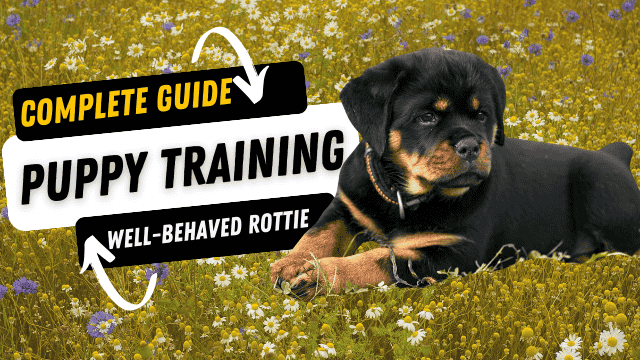


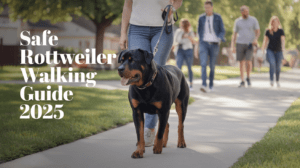

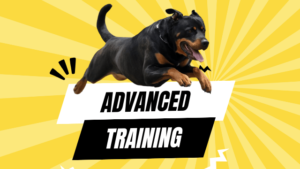
Pingback: Rottweiler Training: The Complete Guide [Expert Tips & Techniques]
Pingback: Rottweiler Puppy Housebreaking: Tips for Success (Potty training)
Pingback: Mastering Basic Commands: Unlock Your Rottweiler Puppy's Potential
Pingback: Rottweiler Training: The Complete Guide [Expert Tips & Techniques]
Pingback: Rottweiler Puppy Housebreaking: Tips for Success (Potty training)
Pingback: 5 Simple Steps to Crate Train Rottweiler Puppy (and Why You Should!)
Pingback: Mastering Basic Commands: Unlock Your Rottweiler Puppy's Potential
Pingback: Title: Raise a Confident Rottweiler: Socialization is Key!
Pingback: Rottweiler Advanced Training: Level Up Your Rottie's Skills
Pingback: Rottweiler Health 101: A Guide to Common Issues & Preventative Care